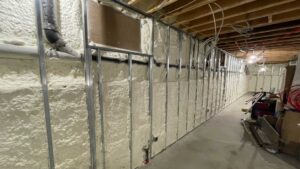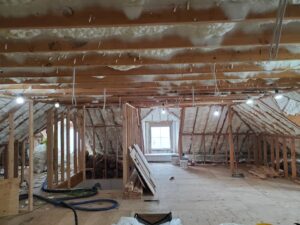Quick Insight: Insulating Your Garage Door
- Reduce Energy Bills: Proper insulation can cut down on energy costs by keeping the garage and adjacent rooms warmer in winter and cooler in summer.
- Protect Your Belongings: Insulation maintains a stable temperature to protect items stored in the garage from extreme temperatures.
- Increase Comfort: A well-insulated garage can extend the comfortable living space in your home.
- Enhance Home Value: Insulation adds value by improving energy efficiency and reducing street noise.
Insulating your garage door is a smart move that pays off in several ways. It’s not just about keeping your car warm in the winter or cool in the summer; it’s about energy efficiency and comfort enhancement throughout your home. An insulated garage can prevent the cold or heat from seeping into your living spaces, leading to lower energy bills and a more comfortable home environment. Plus, it adds an extra layer of protection for your tools, car, and stored items against temperature fluctuations.
Whether you’re a homeowner in New York or New Jersey looking to make your space more energy-efficient and eco-friendly, or a business owner aiming to reduce operational costs, insulating your garage door is a fundamental step towards a greener and more cost-effective property.
Insulation isn’t just a one-time benefit. It’s an investment in your home’s efficiency and comfort that lasts. The initial cost and effort can save you money in the long run and make your home a more pleasant place to be, year-round.

Choosing the Right Insulation for Your Garage Door
When it comes to keeping your garage comfortable and energy-efficient, not all insulation is created equal. The right choice depends on a few key factors: the type of garage door you have, the climate you live in, and the insulation’s R-value. Let’s break it down in simple terms.
Types of Garage Doors
First things first, let’s talk about garage doors. There are mainly two types: steel and wooden. Steel doors have a natural advantage when it comes to insulation. They often come with built-in insulation layers that make them more energy-efficient. Wooden doors, on the other hand, need a bit more help to keep the cold out and the warmth in.
- Steel Garage Doors: These are already somewhat insulated but can benefit from additional insulation, especially in colder climates.
- Wooden Garage Doors: These require rigid insulation, such as foam board, to improve their temperature control capabilities.
R-Value Explanation
Now, onto the R-value. Think of the R-value as a superhero cape for your garage door. The higher the R-value, the more powerful the cape, meaning it’s better at fighting off temperature changes. Here’s a simple guide:
- Detached, Non-Heated Garages: Look for insulation with an R-value of 0 to 6.
- Attached, Non-Heated Garages: Aim for an R-value between 7 to 9.
- Heated Garages: Go for an R-value of 10 to 13.
- Garages with Living Spaces Above: You’ll need an R-value of at least 14.
Climate Considerations
Lastly, let’s not forget about the climate. Your garage door insulation needs can vary greatly depending on whether you’re battling the scorching heat of Arizona or the freezing winters of Minnesota.
- Hot Climates: Reflective insulation can help by bouncing back the sun’s rays, keeping your garage cooler.
- Cold Climates: High R-value materials like fiberglass batts or foam boards are your best bet to keep the warmth inside.
Remember, insulating your garage door is a step towards making your home more energy-efficient and comfortable. Whether you’re DIY-savvy or prefer to call in the pros, understanding these basics will help you make informed decisions.
We’ll dive into a step-by-step guide on how to insulate your garage door, covering everything from measuring and cutting insulation to installing panels and ensuring everything is sealed tight against the elements. Stay tuned for practical tips and tricks that will turn your garage into a well-insulated space, ready to face any season.
Step-by-Step Guide to Insulating a Garage Door
Insulating your garage door is a smart move to enhance your home’s energy efficiency and comfort. Let’s dive into the process, starting with what you’ll need and moving through each step to secure your garage against the elements.
Measuring and Cutting Insulation
Tools needed:
– Gloves and eye protection
– Tape measure
– Utility knife or saw
– Straightedge or ruler
Accurate measurements are crucial. Measure each panel of your garage door from side to side and top to bottom. Garage doors may have panels of different sizes, so measure each one individually.
Cutting techniques: Once you have your measurements, it’s time to cut your insulation material. If you’re using polystyrene sheets or fiberglass batting, lay them on a flat surface. Use a straightedge to guide your utility knife or saw for a clean, straight cut. For reflective foam, you might not need to cut if it’s already in rolls that fit your door panels.
Installing Insulation Panels
Polystyrene sheets: These rigid panels offer good insulation and are easy to cut to size. After cutting, fit each panel into the recesses of your garage door. The snug fit should hold them in place, but you can use adhesive tape for extra security.
Fiberglass batting: This material is a bit more flexible. Cut it to size, then secure it to the garage door panels with the provided clips or adhesive tape. Ensure it’s firmly in place to avoid sagging.
Reflective foam: If you opted for reflective foam, it usually comes with a double-sided adhesive. Remove the protective film and press the foam onto each panel. Make sure there are no air gaps for optimal insulation.
Sealing and Weatherproofing
Doorstop weather stripping: This is crucial for sealing the edges of your garage door. Measure the perimeter of the door and cut the stripping to length. Most weather stripping comes with an adhesive back. Peel and stick it around the door frame to block drafts.
Bottom seal replacement: Over time, the bottom seal of a garage door can wear out, allowing drafts and debris to enter. Remove the old seal, clean the track, and slide the new seal into place. If your door doesn’t have a track, there are seals available that nail or screw directly onto the bottom of the door.
Reducing drafts: Check for gaps around your garage door where air might be escaping. Use foam or rubber seals to fill these gaps. Pay special attention to the corners and where the panels meet when the door is closed.
By following these steps, you’ll significantly improve the insulation of your garage door, making your garage a more comfortable space year-round and saving on energy costs. Taking your time to measure accurately and ensuring a snug fit for all materials will yield the best results.
Cost-Effective Insulation Solutions
Insulating your garage door doesn’t have to empty your wallet. There are several cost-effective solutions that can make a big difference in your garage’s temperature and your home’s energy efficiency. Let’s explore some of the most budget-friendly options.
DIY Kits
One of the simplest ways to insulate your garage door is by using a DIY insulation kit. These kits come with everything you need, including pre-cut panels and a step-by-step guide. They’re designed for easy installation, meaning you won’t need special tools or extensive DIY experience. The convenience of everything being in one package can save you both time and money.
Fiberglass Insulation
Fiberglass insulation is a popular choice for its affordability and effectiveness. It’s the same material often found in the walls of your home and can be easily adapted for garage door insulation. While it’s generally more affordable than other options, it’s important to handle fiberglass with care, wearing gloves and a mask to avoid irritation.
Rigid Panel Insulation
For those seeking a balance between cost and performance, rigid panel insulation made of polystyrene or Styrofoam is an excellent choice. These panels can be cut to fit the specific dimensions of your garage door panels. They offer good insulation properties and are relatively lightweight, making them easy to install. Plus, their rigid nature means they can withstand the wear and tear of a frequently used garage door.
Styrofoam
Styrofoam is another cost-effective material that’s easy to work with. It can be cut to size with a simple utility knife and fits snugly into the garage door panels. While it may not have the highest R-value compared to more expensive options, Styrofoam still provides a significant improvement in insulation over an uninsulated door. It’s a great option for those looking to improve their garage’s energy efficiency without breaking the bank.
Tips for Maximum Efficiency
- Seal all gaps: Even with insulation, gaps around the garage door can let in drafts. Use weatherstripping and caulk to seal these areas.
- Consider the R-value: Higher R-value materials offer better insulation but may cost more. Balance your budget with your insulation needs.
- DIY when possible: Installing insulation yourself can save on labor costs. Many of the options mentioned are suitable for DIY projects.
By choosing one of these cost-effective insulation solutions, you can improve the comfort of your garage space and reduce your energy bills. Whether you opt for a convenient DIY kit, fiberglass, rigid panels, or Styrofoam, you’ll be making a smart investment in your home’s energy efficiency.
The key to effective insulation is not just the material but also proper installation. Ensure that whichever method you choose is installed correctly for the best results. With a little effort and investment, you can enjoy a warmer garage in the winter and a cooler space in the summer.
Continuing on, let’s address some common questions homeowners have about insulating their garage doors, including the impact on temperature regulation and ways to insulate a garage affordably.
Common Questions on Garage Door Insulation
Does Insulating a Garage Door Make a Difference?
Absolutely. Insulating your garage door can significantly improve the temperature regulation inside your garage. By adding insulation, you’re creating a barrier against the outdoor temperature, which means your garage will stay warmer in winter and cooler in summer. This not only makes the space more comfortable but can also lead to energy and cost savings. With a properly insulated garage door, your home’s heating and cooling systems won’t have to work as hard to maintain a stable temperature, leading to lower energy bills.
Will Insulating a Garage Door Keep Cold Out?
Yes, it will. Insulation adds a layer of extreme weather resistance to your garage door, helping to keep the cold air out during the winter months. This improved temperature control means that anything stored in your garage, from your car to paint cans, is protected from the freezing temperatures outside. It’s not just about keeping the garage warmer; it’s about creating a stable environment that protects against temperature fluctuations.
How to Insulate a Garage Cheaply?
Insulating a garage door doesn’t have to break the bank. There are several affordable materials and DIY options available that can make a big difference without a huge investment. Here are a few tips:
- Reflective Foam Boards: These are lightweight and easy to install. You can cut them to size with a simple utility knife and attach them directly to the garage door panels.
- Fiberglass Batts: Another cost-effective option, fiberglass batts can be trimmed to fit the panels of your garage door and secured in place with adhesive tape.
- Weather Stripping: Don’t forget about sealing the gaps! Weather stripping around the edges of your garage door can prevent cold air from sneaking in and warm air from leaking out.
- DIY Kits: Many home improvement stores offer garage door insulation kits that come with everything you need to insulate your garage door yourself. These kits often provide a good balance between cost and effectiveness.
The importance of R-value cannot be overstated. When choosing materials, pay attention to the R-value, which measures the material’s resistance to heat flow. The higher the R-value, the better the insulation. Even if you’re on a tight budget, aim for the highest R-value you can afford to maximize the benefits of your insulation efforts.
By tackling garage door insulation as a DIY project and choosing the right materials, you can enjoy the benefits of a more temperature-controlled, energy-efficient space without spending a lot of money.
Conclusion
Benefits of Insulation
Insulating your garage door is more than just a weekend project; it’s an investment in your home’s comfort and efficiency. Let’s break down why:
- Temperature Control: Insulation keeps your garage warmer in winter and cooler in summer. This means your garage becomes a more usable space year-round, whether it’s for storage, a workshop, or a home gym.
- Energy Savings: A well-insulated garage door helps reduce the amount of energy needed to heat or cool your home, leading to lower utility bills. This is because it minimizes the transfer of outdoor temperatures into your garage and from your garage into your home.
- Protection for Stored Items: By maintaining a more consistent temperature, you protect items stored in your garage from extreme temperature fluctuations that can cause damage.
Maintenance Tips
To keep your garage door insulation in top shape, follow these simple maintenance tips:
- Regular Checks: Inspect your insulation periodically for signs of wear and tear. Look for moisture, which can indicate leaks that need sealing.
- Clean Surfaces: Keep the garage door surface clean to prevent dirt buildup that can affect the insulation’s effectiveness.
- Seal Gaps: Over time, weather stripping around the door can degrade. Check and replace it as needed to keep drafts out.
Spray Foam Insulation USA
At Spray Foam Insulation USA, we understand the importance of a well-insulated home. Our cutting-edge insulation solutions are designed to provide unmatched energy efficiency and comfort. Whether you’re looking to insulate your garage door or any other part of your home, we’re here to help.
Our spray foam insulation offers superior R-values, ensuring that your garage door is effectively insulated against temperature extremes and noise. Plus, our professional team can guide you through the process, ensuring a seamless and effective installation.
Insulating your garage door is not just about immediate benefits. It’s an investment in the future comfort, energy efficiency, and value of your home. With the right approach and support from Spray Foam Insulation USA, you can enjoy a warmer, more efficient space that meets your needs year-round.
In conclusion, how to insulate a garage door is not just a question of enhancing your home’s energy efficiency; it’s about transforming your garage into a more functional and comfortable space. With the right insulation, maintenance, and the expertise of Spray Foam Insulation USA, you can achieve significant energy savings and enjoy a cozy home environment no matter the season.





